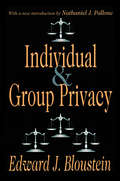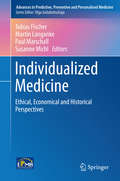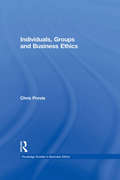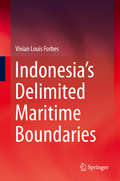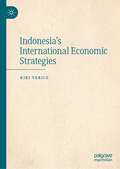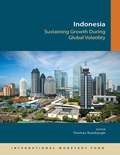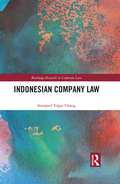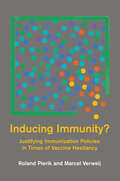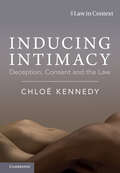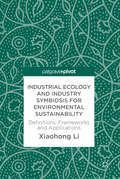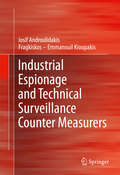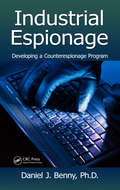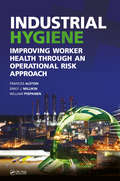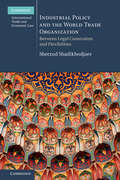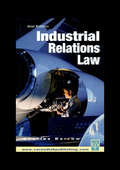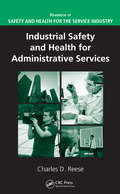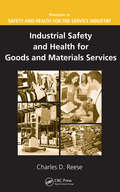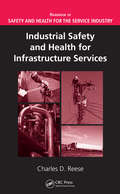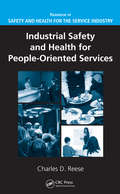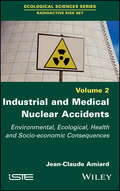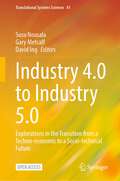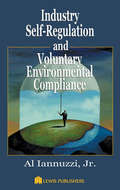- Table View
- List View
Individual Rights And The American Constitution (Fourth Edition)
by Douglas W. Kmiec Stephen B. Presser John C. EastmanThe Fourth Edition of Individual Rights and the American Constitution is designed for a two- or three-semester-hour course on the intellectual sources of and cases dealing with individual human rights, including especially religion, speech, and economic liberties, as well as the concepts of due process and equality. <p><p> This book explores how government power is expressly or impliedly limited to protect individual interests in religious exercise, speech, the freedom from irrational discrimination, and autonomy, as well as economic liberty. It is designed to meet the needs of professors of political science, government, history, and public policy by supplying a casebook that is at once accessible to study by virtue of generous chapter overviews, skillful case selection and editing, and extended introductions and following notes and questions. In addition, out of abundant respect for the rich intellectual tradition that exists within the university, this book fully reflects that Supreme Court cases emerge from history, and history itself reflects centuries of political and philosophical understanding.
Individual and Group Privacy
by Edward J. Bloustein Nathaniel J. PalloneIn exploring a series of problems associated with privacy and the First Amendment, Bloustein defines individual and group privacy, distinguishing them from each other and related concepts. He also identifies the public interest in individual privacy as individual integrity or liberty, and that of group privacy as the integrity of social structure. The legal protection afforded each of these forms of privacy is illustrated at length, as is the clash between them and the constitutional guarantees of the First Amendment and the citizen's general right to know. In his final essay, Bloustein insists that the concept of group privacy is essential to a properly functioning social structure, and warns that it would be disastrous if this principle were neglected as part of an overreaction to the misuse of group confidences that characterized the Nixon era.
Individualized Medicine
by Martin Langanke Tobias Fischer Paul Marschall Susanne MichlIn 2009 the University Medicine Greifswald launched the "Greifswald Approach to Individualized Medicine" (GANI_MED) to implement biomarker-based individualized diagnostic and therapeutic strategies in clinical settings. Individualized Medicine (IM) has led not only to controversies about its potentials, but also about its societal, ethical and health economic implications. This anthology focusses on these areas and includes - next to clinical examples illustrating how the integrated analysis of biomarkers leads to significant improvement of therapeutic outcomes for a subgroup of patients - chapters about the definition, history and epistemology of IM. Additionally there is a focus on conceptual philosophical questions as well as challenges for applied research ethics (informed consent process, the IT-based consent management and the handling of incidental findings). Finally it pays attention to health economic aspects. The possibilities of IM to initiate a paradigm shift in the German health care provision are investigated. Furthermore, it is asked whether the G-DRG system is ready for the implementation of such approaches into clinical routine.
Individuals, Groups, and Business Ethics (Routledge Studies in Business Ethics)
by Chris ProvisCorporate social responsibility has become a heavily discussed topic in business ethics. Identifying some generally accepted moral principles as a basis for discussion, Individuals, Groups, and Business Ethics examines ethical dimensions of our relationships with families, friends and workmates, the extent to which we have obligations as members of teams and communities, and how far ethics may ground our commitments to organisations and countries. It offers an innovative analysis that differentiates amongst our genuine ethical obligations to individuals, counterfeit obligations to identity groups, and complex role-based obligations in organised groups. It suggests that often individuals need intuitive moral judgment developed by experience, reflection and dialogue to identify the individual obligations that emerge for them in complex group situations. These situations include some where people have to discern what their organisations’ corporate social responsibilities imply for them as individuals, and other situations where individuals have to deal with conflicts amongst their obligations or with efforts by other people to exploit them. This book gives an integrated, analytical account of how our obligations are grounded, provides a major theoretical case study of such ethical processes in action, and then considers some extended implications.
Indonesia's Delimited Maritime Boundaries
by Vivian Louis ForbesThis book examines the delimited maritime boundaries of Indonesia with its neighbours. It features carefully drawn maps based on the geographical coordinates of the defined maritime boundaries; the reproduction of a complete set of the primary documents with direct relation to the boundaries; and a comprehensive narrative on the geography and the historical development of the archipelagic State. Indonesia has an immense maritime domain that encompasses much of the sea between Australia and the Asian mainland. In addition, Indonesia is itself made up largely of water: in excess of 17,000 islands, Indonesia's archipelagic and territorial waters together form about three-fifths of the country's sovereign territory. This book offers readers clear, accessible information on the maritime boundaries of the world's largest archipelagic state.
Indonesia's International Economic Strategies
by Kiki VericoThis book discusses Indonesia's international economic strategies. It examines unilateral aspects, foreign direct investments, bilateral economic relations, regional elements, ASEAN's role, and the Indo-Pacific's dynamic frameworks. Starting at the unilateral level, the book outlines how Indonesia managed its macro-economy to recover quickly and adequately from 2020 to 2021 amidst the global COVID-19 pandemic. It argues that Indonesia needs an open economic principle to enhance trade and investment relations. In addition, the book elaborates on how Indonesia transforms its economy with export-oriented long-run investment (Foreign Direct Investment) inflows as a necessary condition for economic transformation as it fits with Indonesia's manufacturing sector, which is critical to the country. Further, the book thoroughly explains Indonesia's bilateral economic relations, from its production networks with Indonesia's major partners to their impacts. It highlights the products which will provide enormous potential benefits for the country. The book also covers regional and mega-regional aspects of Indonesia's economy. Focusing on the Association of Southeast Asian Nations (ASEAN), it emphasises the regional organisation's three essential principles for economic integration: openness, convergence, and inclusiveness. In doing so, research in the book also includes perspectives on how ASEAN sees Asia and the Indo-Pacific framework. It also argues that ASEAN needs centrality in enlarging its economic cooperation with other countries or regions and how a member state's unilateral and bilateral liberalisation are building blocks for ASEAN.
Indonesia: Sustaining Growth During Global Volatility
by Thomas RumbaughThis book is a compilation of eight selected papers and presentations from International Monetary Fund consultations with Indonesia during 2008-2010. Topics include a regional comparison of high inflation in Indonesia, maintaining fiscal stability under uncertainty, Indonesia's commodity boom and competitiveness, corporate governance and leverage trends, and assessing corporate sector vulnerabilities. The editor, Thomas Rumbaugh, is Division Chief in the Asia and Pacific Department at the IMF. Annotation ©2012 Book News, Inc. , Portland, OR (booknews. com)
Indonesian Company Law (Routledge Research in Corporate Law)
by Soonpeel Edgar ChangIn modern countries, a company is commonly categorized as either public or privately-held, depending on whether securities are publicly traded on the open market, into a government-owned company or private company depending on government ownership, or a financial company or non-financial company depending on its main business, and so on. Of course, these categories are generally used in Indonesia as well. A unique aspect in Indonesia is that a well-settled legal practice mainly uses a dichotomy of company types that is rarely popular in foreign countries: a company with foreign direct investment (penanaman modal asing, or PMA) or company with 100% domestic direct investment (penanaman modal dalam negeri, or PMDN). Government plans concerning how to differently regulate these companies frequently becomes a national issue, as it is one of the main standards to evaluate how effectively and willingly the Indonesian government develops its economic policies. Laws, regulations, and actual legal practice also treat the two types of companies differently, based on whether a company has a foreign shareholder. Although many foreign countries are also equipped with similar regulations over companies with foreign direct investment, Indonesia distinctively applies this dichotomy for much wider uses for several reasons. This book is designed to assist students, practitioners, and researchers with clear and comprehensive treatment of key concepts in Indonesian company law. Significant business, economic, and policy issues are highlighted together with a thorough analysis of the important statutory provisions and cases used in the study of Indonesian company law. The book includes the major theoretical approaches used in current company law literature and statutory issues are covered under both the 2007 Indonesian Company Act and the 2007 Indonesian Capital Investment Act. The book will be an essential reference for investors and businesses contemplating entering the Indonesian Market.
Inducing Compliance with International Humanitarian Law
by Heike Krieger Krieger, Heike and Willms, Jan Jan WillmsThe number of armed conflicts featuring extreme violence against the civilian population in areas with no or little State authority has risen significantly since the early 1990s. This phenomenon has been particularly prevalent in the African Great Lakes Region. This collection of essays evaluates, from an interdisciplinary perspective, the various traditional and alternative instruments for inducing compliance with international humanitarian law. In particular, it explores the potential of persuasion, as well as hierarchical means such as criminal justice on the international and domestic level or quasi-judicial mechanisms by armed groups. Furthermore, it evaluates the role and potential of human rights bodies, peacekeeping missions and the UN Security Council's special compliance system for children and armed conflicts. It also considers how Common Article 1 to the Geneva Conventions and the law of State responsibility could both potentially increase compliance with international humanitarian law.
Inducing Immunity?: Justifying Immunization Policies in Times of Vaccine Hesitancy (Basic Bioethics)
by Roland Pierik Marcel VerweijWhy immunization must be made mandatory in times of vaccine hesitancy, and how we can design and implement immunization policies in a practical, trustworthy, and democratic way.We live in perilous times when a significant number of citizens are either defiantly antivaccination or hesitant to accept vaccinations for themselves or for their children. In Inducing Immunity?, legal philosopher Roland Pierik and bioethicist Marcel Verweij, explore ways to regulate collective immunization in as democratic a manner as possible. Approaching the problem as a matter of a conflict between the responsibility of government to protect public health and the basic right to freedom of citizens, Pierik and Verweij argue that John Stuart Mill&’s harm principle—the idea that individuals should be free to act so long as their actions do not harm others—offers a strong basis for coercive immunization policies.Covering childhood immunization policies, as well as vaccination programs aimed at adult citizens, the authors argue that a coercive immunization policy in any liberal democracy must first satisfy the principle of proportionality. This leads them to an in-depth exploration of the role of exemptions, the nature of coercion, and the contents of vaccination programs. In the final part of the book, the authors also discuss the importance and scope of freedom of speech, given how the current spread of misinformation has undermined confidence in vaccines.Offering an in-depth analysis in bioethics and legal philosophy, Inducing Immunity? is a sensible and applicable guide for health professionals, policymakers, and academics alike on how we can—and must—do better with our immunization policies.
Inducing Intimacy: Deception, Consent and the Law (Law in Context)
by Chloë KennedyKennedy presents a new way of evaluating the regulation of deceptively induced intimacy, that is, sex and sexual/romantic relationships, on the basis of an innovative genealogy of legal responses to this conduct. This book traces the development of a range of civil and criminal laws across c. 250 years, showing how using deception to induce intimacy has been legally understood, compensated and punished. It offers an original interpretation of the form and function of these laws by situating them in their social and cultural contexts. It argues that prevailing notions of what makes intimacy valuable, including the role it plays in self-construction, have shaped and constrained the laws' operation. It shows how deceptively induced sex has come to be treated more seriously while the opposite is true of deceptively induced relationships and concludes by presenting a new framework for deciding whether and when deceptively induced intimacy should be regulated by law today.
Industrial Ecology and Industry Symbiosis for Environmental Sustainability
by Xiaohong LiThis book opens up a critical dimension to the interdisciplinary field of Industrial Ecology (IE) and one of its four areas - Industrial Symbiosis (IS). Presenting the concept of closed-loop thinking, this timely book explains how industries and societies can achieve environmental sustainability, a necessity for today’s businesses. Providing a critical review of the definitions and developments of both IE and IS, this study establishes their fundamental role in improving environmental sustainability. The author identifies valuable lessons to be learned and presents conceptual frameworks to guide future IE and IS applications. Transforming industrial systems into closed-loop industrial ecosystems dramatically reduces the negative impact of industrial activities on the environment. Therefore, this book is an important read not only for operations management scholars, but also those who are interested in ensuring an environmentally sustainable future.
Industrial Espionage and Technical Surveillance Counter Measurers
by Iosif Androulidakis Fragkiskos Emmanouil KioupakisThis book examines technical aspects of industrial espionage and its impact in modern companies, organizations, and individuals while emphasizing the importance of intellectual property in the information era. The authors discuss the problem itself and then provide statistics and real world cases. The main contribution provides a detailed discussion of the actual equipment, tools and techniques concerning technical surveillance in the framework of espionage. Moreover, they present the best practices and methods of detection (technical surveillance counter measures) as well as means of intellectual property protection.
Industrial Espionage: Developing a Counterespionage Program
by Daniel J. BennyThe FBI estimates that billions of U.S. dollars are lost each year to foreign and domestic competitors who deliberately target industrial trade secrets. And, although today‘s organizations face unprecedented threats to the security of their proprietary information and assets, most books on industrial espionage fail to supply guidelines for establis
Industrial Hygiene: Improving Worker Health through an Operational Risk Approach (Sustainable Improvements in Environment Safety and Health)
by Frances Alston Emily J. Millikin Willie PiispanenOver the past forty years, the Industrial Hygiene profession has significantly grown, and is expected to continue to grow as workplaces evolve in the development, management, and usage of hazardous materials. This growth in the profession is also related to the shift in public knowledge and perception regarding the acceptance of the health risk from activities performed at work and home. As time progresses, workplaces are being regulated to not only minimize the health imparts to the workforce, but also decrease the likelihood of negatively impacting the environment. Society has become more educated on the potential impacts on human health and the environment that hazardous materials, activities, and environments can pose. As such, there has been a noticeable decrease in the acceptance of risk by workers and the public. The accepted standard of performance for Industrial Hygiene has grown beyond compliance, but now also focuses on improving existing processes and practices to create a workplace free from work related injury and illness. <P><P>Features: <li>Shows application of risk mitigating techniques for industrial hygienists <li>Explains the definition of risk and how it applies to health and safety management <li>Defines the need for quality data management and continuous improvement in assessments <li>Describes the role of the Industrial Hygienist and risk management when responding to emergencies <P><P>Industrial Hygiene: Improving Worker Health through an Operational Risk Approach focuses on the implementation of Industrial Hygiene, using a risk-based approach, in an operational environment. The approaches and methods described in this book are designed to assist the Industrial Hygienist in managing workplace risks, including risks associated with anticipation, recognition, evaluation, and hazard control processes.
Industrial Policy and the World Trade Organization: Between Legal Constraints and Flexibilities (Cambridge International Trade and Economic Law)
by Sherzod ShadikhodjaevThe severe global financial crisis of 2008 could not be overcome without government interventions through industrial policy. This timely book analyses industrial policy from the perspectives of trade law and economics under the WTO system. The author expertly examines both general tools of protecting and supporting domestic producers and specific topics like special economic zones, localization, greening measures and creative economy. In addition to legal texts and jurisprudence, this book extensively utilizes other WTO materials to show what is actually discussed in WTO meetings and forums on relevant issues. Where applicable, the author advances practical recommendations for 'right' or 'optimal' industrial policy in certain contexts based on trade rules, case law and some countries' real experiences. The author concludes this work with some thoughts on concrete actions to be taken at the WTO and national levels and in academic circles in order to better tackle industrial policy issues.
Industrial Relations Law
by Charles Barrow"First Published in 2002, Routledge is an imprint of Taylor & Francis, an informa company."
Industrial Safety and Health for Administrative Services (Handbook of Safety and Health for the Service Industry)
by Charles D. ReeseIndustrial Safety and Health for Administrative Services constitutes a much-needed source for the identification and prevention of most of the injuries and illnesses occurring in the financial and information sectors. The text thoroughly explains the issues of office health management, major safety and electrical hazards, and emergency response to
Industrial Safety and Health for Goods and Materials Services (Handbook of Safety and Health for the Service Industry)
by Charles D. ReeseIndustrial Safety and Health for Goods and Materials Services focuses on the safety requirements of the wholesale and retail trades, including warehousing. This detailed text describes the hazards associated with chemicals, compressed gases, and fire. In addition to discussing the ergonomics behind hand tools, ladders, machine guarding, material ha
Industrial Safety and Health for Infrastructure Services (Handbook of Safety and Health for the Service Industry)
by Charles D. ReeseIndustrial Safety and Health for Infrastructure Services provides an in-depth look into the areas of transportation, utilities, administrative, waste management, and remediation. It covers OSHA regulations in reference to the major safety and health hazards associated within these five fields. This user-friendly text:Provides guidance on removal, d
Industrial Safety and Health for People-Oriented Services (Handbook of Safety and Health for the Service Industry)
by Charles D. ReeseIndustrial Safety and Health for People-Oriented Services focuses on the safety requirements of the tertiary sector of industry's education, health, and hospitality services. This is an instruction manual on managing a safe and healthy environment- one free of biological, chemical, and ergonomics hazards - while adhering to OSHA regulations. In add
Industrial and Medical Nuclear Accidents: Environmental, Ecological, Health and Socio-economic Consequences
by Jean-Claude AmiardThe peaceful use of atomic energy has given rise to a variety of nuclear accidents from the start. This concerns all forms of use, industrial and medical. For each accident, Industrial and Medical Nuclear Accidents details the contamination of the environment, flora and fauna, and quantifies the effects of ionizing radiation. The book also examines the adverse effects on the health, both physical and mental, of the human populations concerned. The monetary cost is also evaluated. The research presented in this book is based on scientifically recognized publications and on the reports of national and international organizations competent in this field (IAEA, WHO, UNSCEAR, IRSN, etc.). The book contains chapters devoted to the most recent accidents (Chernobyl and Fukushima), with a large body of institutional and academic literature.
Industry 4.0 to Industry 5.0: Explorations in the Transition from a Techno-economic to a Socio-technical Future (Translational Systems Sciences #41)
by Gary Metcalf Susu Nousala David IngThis is an Open Access book.In 2015, Industry 4.0 was announced with the rise of industrialization by the European Parliament, supporting policy, research, and infrastructure funding. In 2020, Industry 5.0 was launched as an evolution of Industry 4.0, towards societal and ecological values in a sustainable, human-centric, and resilient transition. In 2023, the IN4ACT research project team completed 4 years of research on the impact on these initiatives.Presentations reviewing the progress of management practices and economics led to conversations about what’s next. The unanticipated rise in late 2022 of Generative AI technologies (e.g. ChatGPT, DALL-E) sparked dialogues with an extended circle of researchers on impacts not considered in 2015 or in 2020. This collection of chapters reflects multiple perspectives on research findings to 2023, prospects for 2024, and considerations on ways the techno-economic industrial revolutions may be reshaped into desirable futures respecting social and ecological concerns.
Industry Genius: Inventions and People Protecting the Climate and Fragile Ozone Layer
by Stephen Andersen Durwood ZaelkeThis book presents the inventive genius behind technological breakthroughs by ten global companies including Alcoa, DaimlerChrysler, Honda, ST Micro and Visteon. Readers will gain understanding and insight into how cutting-edge technology is helping protect the climate and/or the ozone layer, while contributing to the company's bottom line. Each chapter chronicles the challenge and triumph of invention, introduces the engineers and executives who overcome conventional wisdom, and demonstrates the contribution these companies are making to environmental protection. In full colour and crammed with graphics to illustrate the creative process of technological breakthroughs, the book is accessible and informative. The genius of these ten companies will inspire the engineer, the policy-maker, the student, the environmentalist, the CEO and the investor alike.
Industry Self-Regulation and Voluntary Environmental Compliance
by Jr., Al IannuzziWhy self-regulation? With the advent of such concepts as design for the environment, industrial ecology, and the recognized enlightened self-interest that voluntary compliance brings, it is in any company's best interest to avoid fines, liabilities, and bad publicity. Consumer concern and pressure from the marketplace give a competitive advantage t

